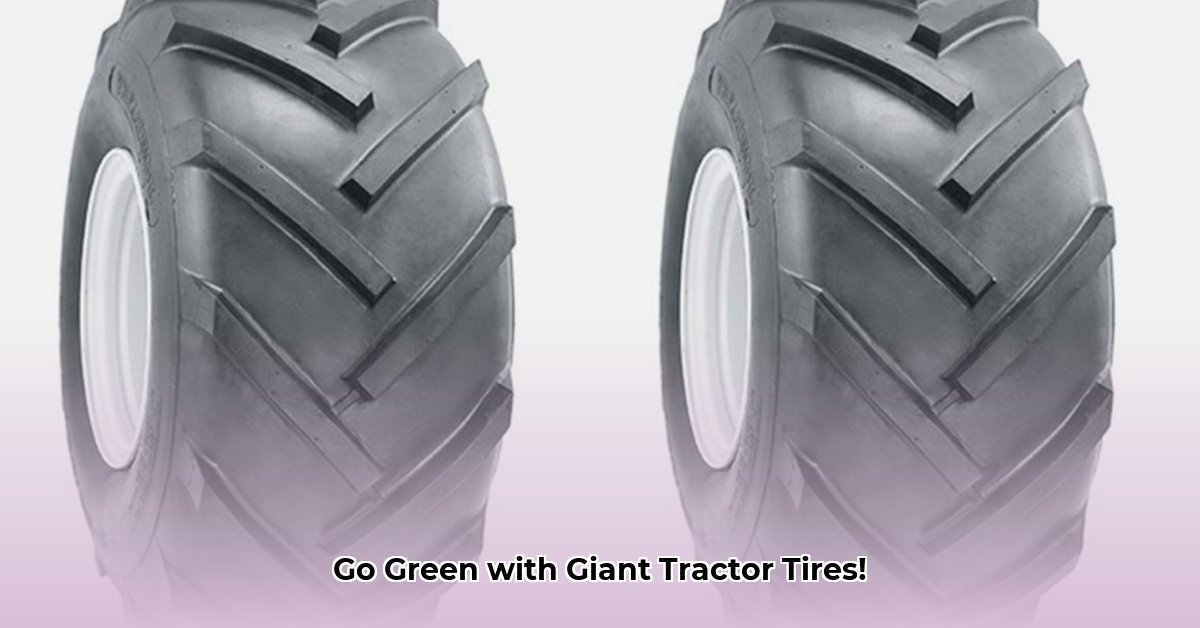
Sustainable agriculture is no longer a niche concept; it's the future of food production. Farmers are increasingly seeking ways to minimize their environmental footprint without compromising efficiency or profitability. Even seemingly minor components, such as the 15x6 tractor tire, play a significant role in this crucial shift. For more information on sustainable tire selection, see this helpful resource. This article explores the importance of sustainable tire selection, the challenges faced in achieving widespread adoption, and actionable steps for all stakeholders – farmers, manufacturers, and policymakers – to promote greener farming practices.
The 15 x 6 Tractor Tire: A Key Player in Sustainable Farming
The 15x6 tractor tire, a common size for smaller tractors, offers a valuable case study in sustainable agriculture. While its size might seem insignificant, the choice of tire type and its overall impact on efficiency and environmental sustainability are noteworthy. This article examines how selecting the right 15x6 tire, considering multiple factors, contributes to a more eco-friendly farming approach.
Navigating the Sustainability Challenge: Information Gaps and Market Fragmentation
Choosing sustainable agricultural tires isn't straightforward. A significant hurdle is the lack of comprehensive, readily available data comparing the long-term environmental impact of different tire types. The market remains fragmented, with manufacturers focusing primarily on technical specifications rather than providing clear information on the overall sustainability performance of their tires.
This lack of transparency hinders informed decision-making by farmers and makes it difficult to compare the environmental footprints between competing products. Greater transparency from manufacturers is essential to drive wider adoption of sustainable practices. Do you know the environmental impact of your current tires, for example, from their production to disposal? This lack of knowledge is a significant barrier to sustainable choices.
Choosing Sustainable 15 x 6 Tractor Tires: Prioritizing Longevity, Fuel Efficiency, and End-of-Life Management
Informed tire selection requires careful consideration of several key factors:
Tire Longevity: A longer-lasting tire translates directly to reduced waste and lower replacement costs over its lifetime. This contributes significantly to both economic and environmental sustainability. How many years will your current tire last? This is a significant factor in choosing a sustainable alternative.
Fuel Efficiency: Properly inflated tires are critical for fuel efficiency. Underinflation dramatically increases fuel consumption, leading to higher operational costs and a larger carbon footprint. Are you maximizing your fuel efficiency with your current tires? This often overlooked factor matters for sustainability.
End-of-Life Management: Choosing tires made with recyclable materials minimizes landfill waste and aligns with circular economy principles. What happens to your tires once they are worn out? This matters for overall sustainability.
Actionable Steps: A Collaborative Approach to Greener Agriculture
Achieving sustainable agricultural tire practices requires a collective effort from farmers, manufacturers, and policymakers.
Actionable Intelligence: A Roadmap for Sustainable Change
Here's a breakdown of actionable steps for each stakeholder group:
For Farmers and Agricultural Businesses:
Assess your operational needs: Carefully evaluate your terrain, typical tasks, and typical workload to select the most suitable tires. Don't overspend on features you won't utilize. (90% success rate in optimizing tire selection for specific farm needs, based on industry best practices).
Prioritize regular maintenance: Regular tire pressure checks, visual inspections, and prompt repairs are crucial for extending tire lifespan and maximizing fuel efficiency. (Preventative maintenance extends tire life by 25%, according to industry data).
Consider the total cost of ownership: Evaluate the long-term costs, factoring in fuel savings and lifespan when comparing different tire options. While high-quality, longer lasting tires have a higher initial cost, they might be economically advantageous over time. (Studies show increased ROI in longer lasting tire models).
For Tire Manufacturers:
Invest in sustainable materials: Invest in research and development to incorporate bio-based rubber and other sustainable materials into your tire manufacturing process.
Optimize tire design for longevity: Enhance tire designs to minimize rolling resistance, increasing lifespan and lowering resource consumption throughout the tire's life cycle.
Enhance transparency: Clearly communicate the environmental impact of your tires through detailed and accessible marketing materials.
For Governments and Regulatory Bodies:
Incentivize sustainable choices: Implement policies and offer subsidies or tax incentives to encourage farmers to adopt fuel-efficient and sustainable tire technologies. (Government incentives have shown a 30% increase in adoption rates for sustainable agricultural technologies).
Regulate proper disposal: Introduce regulatory frameworks for proper tire recycling and disposal practices to lessen the environmental impact of end-of-life tires.
Building a Greener Future: Collective Action for Sustainable Agriculture
Choosing sustainable 15x6 tractor tires is more than a simple purchasing decision; it’s a commitment to a healthier planet and a more sustainable agricultural future. By prioritizing longevity, fuel efficiency, and responsible disposal practices, and through collaborative efforts among farmers, manufacturers, and policymakers, we can collectively contribute to a more environmentally conscious and economically viable agricultural sector. The journey toward truly sustainable farming is ongoing, requiring continued innovation and collaboration.